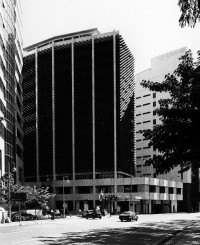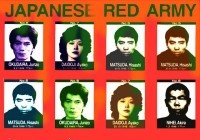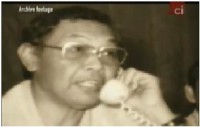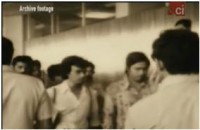Note: Our accounts contain the personal recollections and opinions of the individual interviewed. The views expressed should not be considered official statements of the U.S. government or the Association for Diplomatic Studies and Training. ADST conducts oral history interviews with retired U.S. diplomats, and uses their accounts to form narratives around specific events or concepts, in order to further the study of American diplomatic history and provide the historical perspective of those directly involved.
On August 4th, 1975, five members of the Japanese Red Army or JRA - a militant organization intent on overthrowing the Japanese government and starting a worldwide revolution - stormed the United States embassy on the 9th floor of the AIA Insurance building in Kuala Lumpur, Malaysia, which housed five foreign embassies, including the United States and Sweden. The JRA gunman held 53 people hostage, mostly Malaysians but also including U.S. consul Robert Stebbins and a Swedish diplomat, for four days.  Robert Dillon, a Foreign Service officer in Kuala Lumpur at the time, was working on another floor of the building when it happened. As the crisis progressed, he oversaw negotiations and the security of the hostages during the entire ordeal. He was interviewed by Charles Stuart Kennedy for ADST in 1990; this is his account. Read the entire story at ADST.org
Robert Dillon, a Foreign Service officer in Kuala Lumpur at the time, was working on another floor of the building when it happened. As the crisis progressed, he oversaw negotiations and the security of the hostages during the entire ordeal. He was interviewed by Charles Stuart Kennedy for ADST in 1990; this is his account. Read the entire story at ADST.org
DILLON: I was back at my desk, trying to look important, shuffling through telegrams, thinking undoubtedly deep and important thoughts. All of a sudden, I heard a series of shots. I recognized immediately the sound of small arms fire -- 9 mm pistol shots. I ran to the door of my office; there were people outside milling around wondering what was going on. We recognized quickly that the shooting was taking place on [the 9th] floor. So we rushed down the steps to see what was going on.
There was still some shooting going on. We could see the door of the elevator opening and one of our Malay guards being shot at by someone in the corridor. The guard took a bullet right under the eye and fell back into the elevator. The door then closed and we managed to get the man out on a different floor and to a hospital. Then another guard came up and he was shot through the chin--the bullet came out through the jaw.
We sealed the floor off very quickly with Marines and our security officer stood on the stairs to prevent the perpetrators, whom we did not know at the time, from going upstairs to our other floors. The elevators were shut off. The Malaysian police arrived very quickly and sealed off the floor from below. So the terrorists were locked into the 9th floor. We didn't really know what was going on; we were speculating whether it was some "nut" that had a perceived grievance against the consular section or it was a terrorist attack. In effect, we reached a stalemate for several hours. Occasionally, we would hear firing. Fortunately no one was killed, although there were four wounded.
Sometime during the early afternoon, a note was thrown out by the perpetrators, announcing that they were members of the Japanese Red Army. Their demands were primarily on the Japanese government. The Japanese Deputy Prime Minister happened to be visiting Washington at the time; we assumed that the attack was timed to coincide with that visit. The Japanese had some JRA people in prison; our "invaders" threatened to harm the hostages if their colleagues in Japanese prisons were not released.
At about the same time, a Foreign Service officer, Dick Jackson (who had a beautiful voice) and I were standing at the switchboard. The telephones were still working and a Malay operator was on duty. She answered one of the incoming calls and turned to me, "The head of the terrorists wishes to speak to you." This was my first experience in this kind of a situation, although I had picked up a couple of pointers somewhere along the line. One was that the decision-maker should avoid being one of the intermediaries.
As I said, Dick Jackson was standing next to me. For the next four days, he brilliantly distinguished himself. In any case, since he was standing there, I asked him to answer the call. He instantly appeared to understand the game, although he also had never had any experience. He spoke in a nice, friendly, unthreatening voice. He kept saying; "You know I don't make the decisions, but I will relay your concern to our Chargé who is here in the building". He sounded just like the text book said he should.
By this time -- the episode had now lasted several hours -- a huge crowd had gathered outside our building. Newsmen began descending from all over the world. The Japanese Ambassador arrived. A war room was set up on the ground floor in some offices belonging to the bank that owned the building. The Malaysian Minister of Interior, Ghazali Shafie, came personally.
There were three elevators in the building. Two faced into the lobbies, and by this time, both of those had been disabled and were stuck on the 9th floor. The other elevator, although in the same bank, was the freight elevator and its doors were opposite to the passenger ones. Our communications were through this elevator because the way it faced, no one could shoot through its doors. The steps were closed because we and the terrorists had established fields of fire on the steps. So I went down the freight elevator to the meeting on the first floor. That was the beginning of an exhausting four-day siege.
A negotiation ensued. Henry Kissinger, who was the Secretary of State, was on a plane to Belgrade. He communicated with us; he seemed primarily interested that the American Chargé not agree to anything because "the United States does not negotiate with terrorists," etc. Later, Larry Eagleburger became the main point of contact. He repeated many of Kissinger's injunctions, but in a much more palatable way. I think he understood my role. When I realized that the JRA's demands were against the Japanese and not against us, I was probably the happiest man in the world because, among other things, it made my role a lot easier. The pressure was on the Japanese; the Malaysians just wanted to give in to the terrorists because they wanted to end the incident as rapidly as possible.
When I realized that the JRA's demands were against the Japanese and not against us, I was probably the happiest man in the world because, among other things, it made my role a lot easier. The pressure was on the Japanese; the Malaysians just wanted to give in to the terrorists because they wanted to end the incident as rapidly as possible.
Naturally, the electricity was turned off. Kuala Lumpur is in the tropics and the temperature was in the 90s and very humid. We sweated gallons and gallons of water. We had a generator which ran the elevator. We continued our communications with Washington. Our telephone line to the Operations Center was kept open the whole time.
At the beginning, when Washington called, I answered; then I realized that the same principle which applies to negotiations with terrorists also applies to Washington: let someone else answer the phone. Al LaPorta...became the liaison with Washington. I can still see Al saying very politely to Washington: "I just don't know where Dillon is. He may be downstairs, but in any case, I will get the message to him." Every ambitious so-and-so in Washington wanted to be in on the action; so they all wanted to talk to me and give me their advice. We wanted advice, in small and well conceived doses, but Washington is very difficult to deal with, particularly in situations like this. People there panic; we felt tremendous tension, but not panic.
We had a security officer, Wayne Algire, who was running all over the place as was the Station Chief. We were dropping microphones through the walls in an effort to hear what was happening on the 9th floor. We didn't know how many terrorists there were or how many hostages there were. We knew our consul [Robert Stebbins] was there. We tried to put together a list of who might be held hostage. We speculated that there might have been 20-32 hostages [ed. There were 53]. It turned out that there were six or seven Americans and a few other foreigners, but most of the hostages were Malaysian citizens. We provided food and water to all of them during the four days. The terrorists were very suspicious of the food and water; they were afraid to drink anything we sent because they thought it would be drugged or poisoned.
Finally, the Japanese agreed to exchange some JRA prisoners for our hostages. One of the four JRA prisoners, who was supposed to have been brought from Japan, refused to be part of the exchange. The terrorists didn't believe it. Finally, we were able to patch through a telephone call from our building to the jail where this fourth JRA member was being held. The fellow in Japan just didn't want to be any part of this exchange; he wanted to stay in jail.
Then the question arose about asylum. That was a further excruciating process. We suggested Libya, but they refused. No one else would take them. Finally, the Libyan government agreed to permit the JAL plane to land in their country. I remember sitting with the Japanese ambassador who was sweating buckets; he was very good, but as you can imagine this was a very difficult period for him. As the Japanese ambassador came under greater and greater pressure, his English deteriorated which made matters even more difficult. When we heard that the Libyans would accept the plane, the Japanese ambassador drew a big sigh and said "Ah so" -- exactly what you see and hear in the movies. Then we had to worry about air clearance for the plane between Kuala Lumpur and Libya. We managed to get everybody's agreement except from Iran, where the Shah said if that plane entered Iranian air space, it would be shot down. So we had to work out a longer route, avoiding Iran. The plane had to be refueled once; Ceylon [Sri Lanka] was chosen for that. Sirimavo Bandaranaike was the Prime Minister. The Malaysian Ghazali Shafie, who was a very persuasive man, was on the telephone with her.
Then we had to worry about air clearance for the plane between Kuala Lumpur and Libya. We managed to get everybody's agreement except from Iran, where the Shah said if that plane entered Iranian air space, it would be shot down. So we had to work out a longer route, avoiding Iran. The plane had to be refueled once; Ceylon [Sri Lanka] was chosen for that. Sirimavo Bandaranaike was the Prime Minister. The Malaysian Ghazali Shafie, who was a very persuasive man, was on the telephone with her.
Mrs. Bandaranaike was saying "No" in a very excited tone. She didn't want any part of the refueling. She said if the plane tried to land, she would order her troops to shoot. Ghazali refused to take "No" for an answer; he oozed charm. He was full of understanding for her plight and reassured her of his sympathy for her position. On the other hand, he kept pointing out that if Ceylon didn't let the plane land, some innocent people would die which he was sure no one really wanted.
After an exhaustive 45 minutes, Mrs. Bandaranaike finally gave in. The plane would be allowed to fuel, but would be surrounded by Ceylonese troops which would be instructed to shoot if anybody tried to get out. Ghazali turned around and gave us a big smile. By now, all the arrangements were made, except working out the modalities of the prisoners' exchange.
That also proved to be excruciating. Every step had to be covered. The terrorists had to come down the steps and board a bus which would be waiting at the entrance. They would be accompanied by all the hostages. The bus would then go to the airport. The terrorists agreed to take out all the explosives which they had dug into our walls and explode them on the tarmac before boarding their plane. They demanded that the JRA prisoners be exchanged at the airport. They also demanded that four senior officials fly to Libya with them where they would be released.
At this point, we were talking to the terrorists over some hand-held sets. That enabled us to come down in lock-step; Wayne Algire would say: "I am now going to take one step backward" and the terrorist would say: "OK. I will now take a step." It took us three hours to clear the building -- that was to come down nine flights of stairs. You can imagine how our nerves were at this stage. We had not slept for four nights.
They blew up their explosives-turned out that it was most, but not all. When I saw what a huge crater was made by the explosion, I was shocked; I hadn't realized the full extent of the power on the 9th floor just below us. I was glad that I had been ignorant. The terrorists let the hostages go, one by one, starting with the non-Americans. The last man out was Bob Stebbins, our consul whom we later found out from the other hostages had behaved with great courage and dignity. The plane flew off. The four official hostages, one of whom [became] the Japanese ambassador to Washington, went with the plane to Libya. There they were released and returned to Kuala Lumpur.... When the KL crisis developed, a task force was established in Washington. It did good work. It was very supportive. When it sent a message, it was always an encouraging one which was always helpful. It was the people at the top that were a problem. You do get the feeling that if things go awry, it is your fault. I don't know whether that is paranoia or whether it was just Mr. Kissinger in this case; it probably is just endemic to the way our government works: if things don't go well, it is your fault; if they go right, a lot of people take credit.
When the KL crisis developed, a task force was established in Washington. It did good work. It was very supportive. When it sent a message, it was always an encouraging one which was always helpful. It was the people at the top that were a problem. You do get the feeling that if things go awry, it is your fault. I don't know whether that is paranoia or whether it was just Mr. Kissinger in this case; it probably is just endemic to the way our government works: if things don't go well, it is your fault; if they go right, a lot of people take credit.
We did in his case get a certain amount of credit. Everybody got a Superior Honor award; I got a piece of paper saying that I had done a great job. I was very glad to get it. But during the episode, I must say that I did not feel that I was getting much support from the top of the U.S. government. You feel that everyone else is running for cover so that if something awful happens, they can distance themselves from catastrophe. I had the impression that at the top levels in Washington, where the ambitious people work, everyone was making it quite clear that whatever happened, he or she had done the right thing and that if matters went awry he or she could not be faulted.
